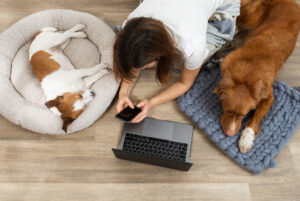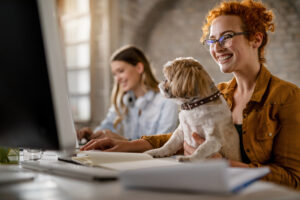The annual #takeyourdogtoworkday began in 1999 as an initiative by US-based Pet Sitters International. It was designed to “celebrate the great companions dogs make and promote their adoptions”. The day is observed on the first Friday after Father’s Day in the US: in 2020, that falls on 26 June.
Of course, this year is unlike any in living memory, with many people – particularly office workers – working from home as the world continues to grapple with the effects of COVID-19. That means that more people than ever before are likely to take their dog to work for the day this year – by staying home with them.
Paws N’ All asked three Aussie vets about the things they commonly see and what advice they have for anyone who is working from home with a dog: their 7 tips are outlined below.
But if you really are planning to leave the house your pup in toe for the day, consider this first-hand advice from other people who have brought their dogs to work. The RSPCA also has some tips before you take your dog into the office.

What to look out for when working from home with a dog
1 – Let sleeping dogs lie
“Dogs may be getting less sleep during the day than they are used to, because people are now at home all day,” explains Dr Michelle Trebeck of Figtree Veterinary Clinic in Sydney.
“That could manifest in some behavioural issues.”
Dr Trebeck suggests let your dog have regular naps throughout the day, just as they would if you were out at work all day. This time out is particularly important if you have young kids at home too.
2 – Distractions are good – for your dog
You may find it really hard to concentrate and focus on doing your work with your dog constantly demanding attention. So instead of letting your dog become a distraction, give them one instead.
Dr Alison Moran of Mona Vale Veterinary Hospital in Sydney points out that smell is a major stimulant for dogs.
“If you look at a dog’s brain, 30% of it is put aside for smell – dogs get stir crazy when they’re not taken for walks not because of lack of exercise, but the lack of smells.”
As such, she recommends using this to your advantage by giving your dog smell-based games and activities.
“Snuffle mats and treat balls are great for this. Alternatively, you can play hide-and-seek using treats that your dog has to hunt out, or you can scatter feed them with kibble or dry treats. Raw (never cooked!) bones are also great at keeping dogs busy, plus they have the added bonus of being good for their teeth and oral health!”
Meanwhile Dr Nic Archer of Fortitude Valley Vet in Brisbane notes that there are dedicated doggy TV shows and YouTube videos that some dogs love to watch.
3 – Mind your step!
You’re probably not used to having a dog in the workplace, so you may not think twice about getting up from your desk to grab a drink or visit the bathroom.
But while working from home with a dog, it’s important to be mindful of where your dog is. For example, they could be asleep at your feet, making them a trip hazard.
Indeed, pets can be an occupational health and safety hazard, and many employers will specifically state that you should not have your dog or cat in your dedicated work space for this reason.
However, your dog’s health also comes into this equation.
“Be careful of your wheelie chair and running over their tails or paws!” Dr Trebeck warns.

4 – Inside should be quiet time
Vets and dog behaviouralists suggest it’s a good idea to teach your dog from an early age that outdoors is for play, but indoors is quiet time. This distinction can be really useful for allowing you to work from home with minimal distractions.
But as Dr Archer explains, not allowing your dog to run indoors – particularly on hard, slippery floors – is also really important to minimise injuries.
“We do see cases of dogs playing zoomies in the house, or jumping on and off couches, which can cause injuries like cranial cruciate ligament tears and muscle strains,” he says.
5 – Walkies!
A long day at the home office shouldn’t stop you from taking your dog for walks. Both you and your dog will benefit from the physical exercise and it also helps reduce cabin fever in you both to get outside in the fresh air.
But be sure to get the balance right. Dr Moran says that too much exercise can actually be harmful for older dogs with arthritis, and similarly, not enough exercise can cause arthritic joints to become stiff and more painful.
Meanwhile Dr Trebeck says that a good walk in the morning before you start work is a good idea. This it will tire your dog and encourage them to sleep during the day, allowing you to work free from distractions.
6 – Supervision is not just for kids
Working from home may mean that you have equipment that isn’t normally there. This could be laptops, a printer, monitors or headphones. These devices – and especially their cables – can be tempting for your dog to chew on or play with.
In fact, Dr Archer says it’s important to never leave your dog unsupervised indoors – whether you’re at home with them or not.
“We see a lot of bored pets that need to have some sort of self-harm treated. Virtually all of these could have been avoided if they had been properly supervised. This includes pets jumping off high balconies, swallowing foreign objects that can be toxic or get become an internal obstruction.”
Dr Nick Archer, Fortitude Valley Vets
Dr Trebeck adds that it can be useful to give your dog a dedicated space inside while you’re working.
“Crate training is great, especially if you have kids, to give the dog some space,” she says. “Plus it allows you to keep an eye on them. If you give them a little bit of attention now and again, they’ll be less likely to annoy you.”
7 – Food for thought
As we humans know only too well, exercise and diet go hand in hand. And just as doctors are urging us not to overeat while we’re working from home, vets urge the same thing while we’re working from home with dogs.
The temptation can be to keep giving your dog lots of treats throughout the day – because “who can resist that face?!” But the danger is that your dog can become overweight, in turn leading to all sorts of health problems.
“Be careful of the fat content too,” says Dr Archer. “I generally prefer dehydrated, 100% lean muscle treats so they don’t pile on the calories.”
There’s nothing wrong with giving your dog healthy treats every now and again, just be sure you do it in moderation!
Sources:
Interviews conducted with each vet between 9 and 14 April 2020 as part of our ebook Guide for dog owners during COVID-19.










